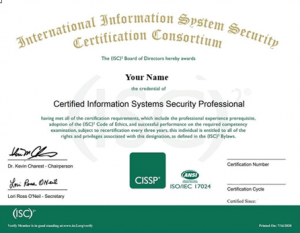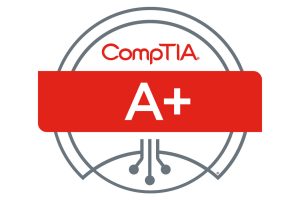
CISSP – Certified Information Systems Security Professional
Mục lục
- Giới thiệu sơ lược về CISSP
- Nội dung chương trình
- Kết quả đạt được
- Cơ hội việc làm có thể có
- Đối tượng tham gia
- Thời hạn chứng chỉ
- Đơn Vị Cung Cấp Chứng Chỉ
- Chi tiết bài kiểm tra

CISSP
Giới thiệu sơ lược về chứng chỉ CISSP
CISSP (Certified Information Systems Security Professional) là một trong những chứng chỉ bảo mật hàng đầu trên toàn cầu do (ISC)² (International Information System Security Certification Consortium) cấp. Chứng chỉ này công nhận kiến thức và kỹ năng của các chuyên gia bảo mật thông tin trong việc thiết kế, triển khai và quản lý các chương trình bảo mật hiệu quả.
Nội dung chương trình
Chương trình CISSP bao gồm 8 lĩnh vực (domains) chính trong bảo mật thông tin:
Security and Risk Management (Quản lý Bảo mật và Rủi ro): Bao gồm các khái niệm về an ninh thông tin, quản lý rủi ro, đạo đức nghề nghiệp và quản lý chương trình bảo mật.
1.1 – Understand, adhere to, and promote professional ethics
- ISC2 Code of Professional Ethics
- Organizational code of ethics
1.2 – Understand and apply security concepts
- Confidentiality, integrity, and availability, authenticity, and nonrepudiation (5 Pillars of Information Security)
1.3 – Evaluate and apply security governance principles
- Alignment of the security function to business strategy, goals, mission, and objectives
- Organizational processes (e.g., acquisitions, divestitures, governance committees)
- Organizational roles and responsibilities
- Security control frameworks (e.g., International Organization for Standardization (ISO), National Institute of Standards and Technology (NIST), Control Objectives for Information and Related Technology (COBIT), Sherwood Applied Business Security Architecture (SABSA), Payment Card Industry (PCI), Federal Risk and Authorization Management Program (FedRAMP))
- Due care/due diligence
1.4 – Understand legal, regulatory, and compliance issues that pertain to information security in a holistic context
- Cybercrimes and data breaches
- Licensing and Intellectual Property requirements
- Import/export controls
- Transborder data flow
- Issues related to privacy (e.g., General Data Protection Regulation (GDPR), California Consumer Privacy Act, Personal Information Protection Law, Protection of Personal Information Act)
- Contractual, legal, industry standards, and regulatory requirements
1.5 – Understand requirements for investigation types (i.e., administrative, criminal, civil, regulatory, industry standards)
1.6 – Develop, document, and implement security policy, standards, procedures, and guidelines
- Alignment of the security function to business strategy, goals, mission, and objectives
- Organizational processes (e.g., acquisitions, divestitures, governance committees)
- Organizational roles and responsibilities
- Security control frameworks (e.g., International Organization for Standardization (ISO), National Institute of Standards and Technology (NIST), Control Objectives for Information and Related Technology (COBIT), Sherwood Applied Business Security Architecture (SABSA), Payment Card Industry (PCI), Federal Risk and Authorization Management Program (FedRAMP))
- Due care/due diligence
1.7 – Identify, analyze, assess, prioritize, and implement Business Continuity (BC) requirements
- Business impact analysis (BIA)
- External dependencies
1.8 – Contribute to and enforce personnel security policies and procedures
- Candidate screening and hiring
- Employment agreements and policy driven requirements
- Onboarding, transfers, and termination processes
- Vendor, consultant, and contractor agreements and controls
1.9 – Understand and apply risk management concepts
- Threat and vulnerability identification
- Risk analysis, assessment, and scope
- Risk response and treatment (e.g., cybersecurity insurance)
- Applicable types of controls (e.g., preventive, detection, corrective)
- Control assessments (e.g., security and privacy)
- Continuous monitoring and measurement
- Reporting (e.g., internal, external)
- Continuous improvement (e.g., risk maturity modeling)
- Risk frameworks (e.g., International Organization for Standardization (ISO), National Institute of Standards and Technology (NIST), Control Objectives for Information and Related Technology (COBIT), Sherwood Applied Business Security Architecture (SABSA), Payment Card Industry (PCI))
1.10 – Understand and apply threat modeling concepts and methodologies
1.11 – Apply Supply Chain Risk Management (SCRM) concepts
- Risks associated with the acquisition of products and services from suppliers and providers (e.g., product tampering, counterfeits, implants)
- Risk mitigations (e.g., third-party assessment and monitoring, minimum security requirements, service level requirements, silicon root of trust, physically unclonable function, software bill of materials)
1.12 – Establish and maintain a security awareness, education, and training program
- Methods and techniques to increase awareness and training (e.g., social engineering, phishing, security champions, gamification)
- Periodic content reviews to include emerging technologies and trends (e.g., cryptocurrency, artificial intelligence (AI), blockchain)
- Program effectiveness evaluation
Asset Security (Bảo mật Tài sản): Đề cập đến các phương pháp bảo vệ tài sản thông tin, phân loại tài sản và quản lý dữ liệu.
2.1 – Identify and classify information and assets
- Data classification
- Asset Classification
2.2 – Establish information and asset handling requirements
2.3 – Provision information and assets securely
- Information and asset ownership
- Asset inventory (e.g., tangible, intangible)
- Asset management
2.4 – Manage data lifecycle
- Data roles (i.e., owners, controllers, custodians, processors, users/subjects)
- Data collection
- Data location
- Data maintenance
- Data retention
- Data remanence
- Data destruction
2.5 – Ensure appropriate asset retention (e.g., End of Life (EOL), End of Support)
2.6 – Determine data security controls and compliance requirements
- Data states (e.g., in use, in transit, at rest)
- Scoping and tailoring
- Standards selection
- Data protection methods (e.g., Digital Rights Management (DRM), Data Loss Prevention (DLP), Cloud Access Security Broker (CASB))
Security Architecture and Engineering (Kiến trúc và Kỹ thuật Bảo mật): Bao gồm các nguyên tắc và khái niệm kiến trúc bảo mật, thiết kế hệ thống bảo mật và các phương pháp mã hóa.
3.1 – Research, implement and manage engineering processes using secure design principles
- Threat modeling
- Least privilege
- Defense in depth
- Secure defaults
- Fail securely
- Segregation of Duties (SoD)
- Keep it simple and small
- Zero trust or trust but verify
- Privacy by design
- Shared responsibility
- Secure access service edge
3.2 – Understand the fundamental concepts of security models (e.g., Biba, Star Model, Bell-LaPadula)
3.3 – Select controls based upon systems security requirements
3.4 – Understand security capabilities of Information Systems (IS) (e.g., memory protection, Trusted Platform Module (TPM), encryption/decryption)
3.5 – Assess and mitigate the vulnerabilities of security architectures, designs, and solution elements
- Client-based systems
- Server-based systems
- Database systems
- Cryptographic systems
- Industrial Control Systems (ICS)
- Cloud-based systems (e.g., Software as a Service (SaaS), Infrastructure as a Service (IaaS), Platform as a Service (PaaS))
- Distributed systems
- Internet of Things (IoT)
- Microservices (e.g., application programming interface (API))
- Containerization
- Serverless
- Embedded systems
- High-Performance Computing systems
- Edge computing systems
- Virtualized systems
3.6 – Select and determine cryptographic solutions
- Cryptographic life cycle (e.g., keys, algorithm selection)
- Cryptographic methods (e.g., symmetric, asymmetric, elliptic curves, quantum)
- Public key infrastructure (PKI) (e.g., quantum key distribution
3.7 – Understand methods of cryptanalytic attacks
- Brute force
- Ciphertext only
- Known plaintext
- Frequency analysis
- Chosen ciphertext
- Implementation attacks
- Side-channel
- Fault injection
- Timing
- Man-in-the-Middle (MITM)
- Pass the hash
- Kerberos exploitation
- Ransomware
3.8 – Apply security principles to site and facility design
3.9 – Design site and facility security controls
- Wiring closets/intermediate distribution facilities
- Server rooms/data centers
- Media storage facilities
- Evidence storage
- Restricted and work area security
- Utilities and Heating, Ventilation, and Air Conditioning (HVAC)
- Environmental issues (e.g., natural disasters, man-made)
- Fire prevention, detection, and suppression
- Power (e.g., redundant, backup)
3.10 – Manage the information system lifecycle
- Stakeholders needs and requirements
- Requirements analysis
- Architectural design
- Development /implementation
- Integration
- Verification and validation
- Transition/deployment
- Operations and maintenance/sustainment
- Retirement/disposal
Communication and Network Security (Bảo mật Mạng và Truyền thông): Tập trung vào các khái niệm về bảo mật mạng, cấu hình mạng, bảo vệ và kiểm soát giao tiếp.
4.1 – Apply secure design principles in network architectures
- Open System Interconnection (OSI) and Transmission Control Protocol/Internet Protocol (TCP/IP) models
- Internet Protocol (IP) version 4 and 6 (IPv6) (e.g., unicast, broadcast, multicast, anycast)
- Secure protocols (e.g., Internet Protocol Security (IPSec), Secure Shell (SSH), Secure Sockets Layer (SSL)/ Transport Layer Security (TLS))
- Implications of multilayer protocols
- Converged protocols (e.g., Internet Small Computer Systems Interface (iSCSI), Voice over Internet Protocol (VoIP), InfiniBand over Ethernet, Compute Express Link)
- Transport architecture (e.g., topology, data/control/management plane, cut-through/store-and-forward)
- Performance metrics (e.g., bandwidth, latency, jitter, throughput, signal-to-noise ratio)
- Traffic flows (e.g., north-south, east-west)
- Physical segmentation (e.g., in-band, out-of-band, air-gapped)
- Logical segmentation (e.g., virtual local area networks (VLANs), virtual private networks (VPNs), virtual routing and forwarding, virtual domain)
- Micro-segmentation (e.g., network overlays/encapsulation; distributed firewalls, routers, intrusion detection system (IDS)/intrusion prevention system (IPS), zero trust)
- Edge networks (e.g., ingress/egress, peering)
- Wireless networks (e.g., Bluetooth, Wi-Fi, Zigbee, satellite)
- Cellular/mobile networks (e.g., 4G, 5G)
- Content distribution networks (CDN)
- Software defined networks (SDN), (e.g., application programming interface (API), Software-Defined Wide- Area Network, network functions virtualization)
- Virtual Private Cloud (VPC)
- Monitoring and management (e.g., network observability, traffic flow/shaping, capacity management, fault detection and handling)
4.2 – Secure network components
- Operation of infrastructure (e.g., redundant power, warranty, support)
- Transmission media (e.g., physical security of media, signal propagation quality)
- Network Access Control (NAC) systems (e.g., physical, and virtual solutions)
- Endpoint security (e.g., host-based)
4.3 – Implement secure communication channels according to design
- Voice, video, and collaboration (e.g., conferencing, Zoom rooms)
- Remote access (e.g., network administrative functions)
- Data communications (e.g., backhaul networks, satellite)
- Third-party connectivity (e.g., telecom providers, hardware support)
Identity and Access Management (Quản lý Danh tính và Truy cập): Đề cập đến các quy trình và công nghệ quản lý quyền truy cập và danh tính người dùng.
5.1 – Control physical and logical access to assets
- Information
- Systems
- Devices
- Facilities
- Applications
- Services
5.2 – Design identification and authentication strategy (e.g., people, devices, and services)
- Groups and Roles
- Authentication, Authorization and Accounting (AAA) (e.g., multi-factor authentication (MFA), password-less authentication)
- Session management
- Registration, proofing, and establishment of identity
- Federated Identity Management (FIM)
- Credential management systems (e.g., Password vault)
- Single sign-on (SSO)
- Just-In-Time
5.3 – Federated identity with a third-party service
- On-premise
- Cloud
- Hybrid
5.4 – Implement and manage authorization mechanisms
- Role-based access control (RBAC)
- Rule based access control
- Mandatory access control (MAC)
- Discretionary access control (DAC)
- Attribute-based access control (ABAC)
- Risk based access control
- Access policy enforcement (e.g., policy decision point, policy enforcement point)
5.5 – Manage the identity and access provisioning lifecycle
- Account access review (e.g., user, system, service)
- Provisioning and deprovisioning (e.g., on /off boarding and transfers)
- Role definition and transition (e.g., people assigned to new roles)
- Privilege escalation (e.g., use of sudo, auditing its use)
- Service accounts management
5.6 – Implement authentication systems
Security Assessment and Testing (Đánh giá và Kiểm tra Bảo mật): Các phương pháp và công cụ để đánh giá bảo mật hệ thống, thực hiện kiểm tra và giám sát an ninh.
6.1 – Design and validate assessment, test, and audit strategies
- Internal (e.g., within organization control)
- External (e.g., outside organization control)
- Third-party (e.g., outside of enterprise control)
- Location (e.g., on-premises, cloud, hybrid)
6.2 – Conduct security control testing
- Vulnerability assessment
- Penetration testing (e.g., red, blue, and/or purple team exercises)
- Log reviews
- Synthetic transactions/benchmarks
- Code review and testing
- Misuse case testing
- Coverage analysis
- Interface testing (e.g., user interface, network interface, application programming interface (API))
- Breach attack simulations
- Compliance checks
6.3 – Collect security process data (e.g., technical and administrative)
- Account management
- Management review and approval
- Key performance and risk indicators
- Backup verification data
- Training and awareness
- Disaster Recovery (DR) and Business Continuity (BC)
6.4 – Analyze test output and generate report
- Remediation
- Exception handling
- Ethical disclosure
6.5 – Conduct or facilitate security audits
- Internal (e.g., within organization control)
- External (e.g., outside organization control)
- Third-party (e.g., outside of enterprise control)
- Location (e.g., on-premises, cloud, hybrid)
Security Operations (Hoạt động Bảo mật): Bao gồm quản lý sự cố, điều hành các hoạt động bảo mật và bảo vệ liên tục.
7.1 – Understand and comply with investigations
- Evidence collection and handling
- Reporting and documentation
- Investigative techniques
- Digital forensics tools, tactics, and procedures
- Artifacts (e.g., data, computer, network, mobile device)
7.2 – Conduct logging and monitoring activities
- Intrusion detection and prevention (IDPS)
- Security Information and Event Management (SIEM)
- Continuous monitoring and tuning
- Egress monitoring
- Log management
- Threat intelligence (e.g., threat feeds, threat hunting)
- User and Entity Behavior Analytics (UEBA)
7.3 – Perform Configuration Management (CM) (e.g., provisioning, baselining, automation)
7.4 – Apply foundational security operations concepts
- Need-to-know/least privilege
- Separation of Duties (SoD) and responsibilities
- Privileged account management
- Job rotation
- Service-level agreements (SLA)
7.5 – Apply resource protection
- Media management
- Media protection techniques
- Data at rest/data in transit
7.6 – Conduct incident management
- Detection
- Response
- Mitigation
- Reporting
- Recovery
- Remediation
- Lessons learned
7.7 – Operate and maintain detection and preventative measures
- Firewalls (e.g., next generation, web application, network)
- Intrusion Detection Systems (IDS) and Intrusion Prevention Systems (IPS)
- Whitelisting/blacklisting
- Third-party provided security services
- Sandboxing
- Honeypots/honeynets
- Anti-malware
- Machine learning and Artificial Intelligence (AI) based tools
7.8 – Implement and support patch and vulnerability management
7.9 – Understand and participate in change management processes
7.10 – Implement recovery strategies
- Backup storage strategies (e.g., cloud storage, onsite, offsite)
- Recovery site strategies (e.g., cold vs. hot, resource capacity agreements)
- Multiple processing sites
- System resilience, high availability (HA), Quality of Service (QoS), and fault tolerance
7.11 – Implement Disaster Recovery (DR) processes
- Response
- Personnel
- Communications (e.g., methods)
- Assessment
- Restoration
- Training and awareness
- Lessons learned
7.12 – Test Disaster Recovery Plans (DRP)
- Read-through/tabletop
- Walkthrough
- Simulation
- Parallel
- Full interruption
- Communications (e.g., stakeholders, test status, regulators)
7.13 – Participate in Business Continuity (BC) planning and exercises
7.14 – Implement and manage physical security
- Perimeter security controls
- Internal security controls
7.15 – Address personnel safety and security concerns
- Travel
- Security training and awareness (e.g., insider threat, social media impacts, two-factor authentication (2FA) fatigue)
- Emergency management
- Duress
Software Development Security (Bảo mật Phát triển Phần mềm): Các nguyên tắc và thực hành bảo mật trong quá trình phát triển phần mềm.
8.1 – Understand and integrate security in the Software Development Life Cycle (SDLC)
- Development methodologies (e.g., Agile, Waterfall, DevOps, DevSecOps, Scaled Agile Framework)
- Maturity models (e.g., Capability Maturity Model (CMM), Software Assurance Maturity Model (SAMM))
- Operation and maintenance
- Change management
- Integrated Product Team
8.2 – Identify and apply security controls in software development ecosystems
- Programming languages
- Libraries
- Tool sets
- Integrated Development Environment
- Runtime
- Continuous Integration and Continuous Delivery (CI/CD)
- Software configuration management (CM)
- Code repositories
- Application security testing (e.g., static application security testing (SAST), dynamic application security testing (DAST), software composition analysis, Interactive Application Security Test (IAST))
8.3 – Assess the effectiveness of software security
- Auditing and logging of changes
- Risk analysis and mitigation
8.4 – Assess security impact of acquired software
- Commercial-off-the-shelf (COTS)
- Open source
- Third-party
- Managed services (e.g., enterprise applications)
- Cloud services (e.g., Software as a Service (SaaS), Infrastructure as a Service (IaaS), Platform as a Service (PaaS))
8.5 – Define and apply secure coding guidelines and standards
- Security weaknesses and vulnerabilities at the source-code level
- Security of application programming interfaces (API)
- Secure coding practices
- Software-defined security
Kết quả đạt được
Những người đạt được chứng chỉ CISSP chứng minh được rằng họ có kiến thức và kỹ năng cần thiết để bảo vệ các hệ thống thông tin khỏi các mối đe dọa. Họ có khả năng thiết kế, triển khai và quản lý các chiến lược bảo mật toàn diện và hiệu quả.
Cơ hội việc làm có thể có
Các chuyên gia có chứng chỉ CISSP có thể đảm nhiệm nhiều vị trí quan trọng trong lĩnh vực bảo mật thông tin, bao gồm:
- Chief Information Security Officer (CISO): Giám đốc An ninh Thông tin
- Security Consultant: Tư vấn viên Bảo mật
- Security Manager: Quản lý Bảo mật
- IT Director/Manager: Giám đốc/Quản lý Công nghệ Thông tin
- Network Architect: Kiến trúc sư Mạng
- Security Analyst: Nhà phân tích Bảo mật
Đối tượng tham gia
Chứng chỉ CISSP phù hợp với các chuyên gia bảo mật thông tin có ít nhất năm năm kinh nghiệm làm việc trực tiếp trong ít nhất hai trong tám lĩnh vực của CISSP CBK (Common Body of Knowledge).
Thời hạn chứng chỉ
Chứng chỉ CISSP có hiệu lực trong ba năm. Để duy trì chứng chỉ, các chuyên gia cần hoàn thành 120 giờ CPE (Continuing Professional Education) và đóng phí duy trì hàng năm.
Đơn vị cung cấp chứng chỉ
Chứng chỉ CISSP được cấp bởi (ISC)², một tổ chức phi lợi nhuận chuyên cung cấp các chứng chỉ và giáo dục trong lĩnh vực bảo mật thông tin.
Chi tiết bài kiểm tra
Bài kiểm tra CISSP gồm 250 câu hỏi trắc nghiệm kéo dài 6 giờ, bao gồm các câu hỏi về cả tám lĩnh vực bảo mật thông tin. Bài kiểm tra được đánh giá theo thang điểm từ 0 đến 1000, và điểm tối thiểu để đạt chứng chỉ là 700. Bài kiểm tra được tổ chức tại các trung tâm khảo thí Pearson VUE trên toàn thế giới.
Bài kiểm tra CISSP CAT (Computerized Adaptive Testing): đây là bài kiểm tra thích ứng trên máy tính cho tất cả các kỳ thi CISSP tiếng Anh trên toàn thế giới. Dựa trên cùng một đề cương nội dung bài kiểm tra như bài kiểm tra tuyến tính, dạng cố định, CISSP CAT là cách đánh giá năng lực của bạn chính xác và hiệu quả hơn. CISSP CAT cho phép bạn chứng minh kiến thức của mình bằng cách trả lời ít câu hỏi hơn và hoàn thành bài kiểm tra trong một nửa thời gian.
Chi tiết được thống kê trong hai bảng sau:
Tổng quan bài thi:
| Length of exam | 3 hours |
| Number of items | 100 – 150 |
| Item format | Multiple choice and advanced innovative items |
| Passing grade | 700 out of 1000 points |
| Exam language availability | Chinese, English, German, Japanese, Spanish |
| Testing center | ISC2 Authorized PPC and PVTC Select Pearson VUE Testing Centers |
Chi tiết bài thi:
| Domains | Average Weight |
| 1. Security and Risk Management | 16% |
| 2. Asset Security | 10% |
| 3. Security Architecture and Engineering | 13% |
| 4. Communication and Network Security | 13% |
| 5. Identity and Access Management (IAM) | 13% |
| 6. Security Assessment and Testing | 12% |
| 7. Security Operations | 13% |
| 8. Software Development Security | 10% |
| Total | 100% |
Tag:Course



